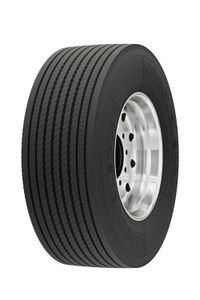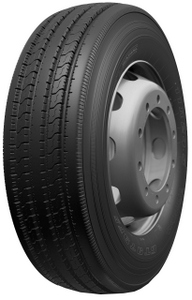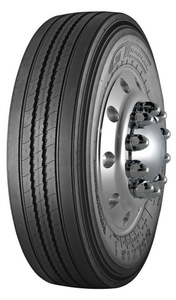
For commercial fleets, two of the top expenditures are on fuel and tires. The greater the knowledge of what fuel-efficient tires are available and what benefits can be gained by using them can improve how tire dealers serve fleet customers.
Tire manufacturers say the impact on a fleet’s bottom line is one of the biggest incentives for them to use fuel-efficient medium truck tires.
“Once a fleet establishes their freight rate with their customers, any way a fleet can reduce their costs without sacrificing their services adds to their bottom line,” says Lowell Slimp, senior commercial products manager at Toyo Tires USA Corp. “Using fuel-efficient tires is one of the ways a fleet can do that.”
William Estupinan, vice president of technical service for Giti Tire USA, says rolling resistance contributes to 35% of the power requirement for a standard tractor-trailer, so tires play an important role in fuel efficiency.
“Fuel-efficient tires, which are designed with special compounds, tread patterns, shallower depths and an enhanced casing profile, can save as much as 3%-5% of fuel consumption,” he says. “This may seem like a small portion but the bigger the fleet, the bigger the savings in fuel costs.”
Aaron Murphy, vice president of China Manufacturers Alliance, agrees that saving money on fuel is a huge motivator for purchasing fuel-efficient tires, but also cites the environment as another factor for seeking low rolling resistance radials.
“From an economic standpoint, lower rolling resistant tires allow you to move trucks and freight with less energy and fuel, obviously offering savings to the fleet,” he says. “There’s also a global emphasis on becoming a more green society. If we can perform the same amount of work with less energy, it obviously saves natural resources and creates a smaller carbon footprint for everything we do.”
Fuel Efficient Customer
Currently the fuel-efficient market for truck tires is highly vocation-specific, the tiremakers note.
“The one application that we see fuel-efficient tires used most is the line-haul fleets. When you’re running long distances where you don’t have outside environmental factors that effect your fuel efficiency, the benefits can be significant,” Murphy says.
“As a general rule the more fuel-efficient fleets tend to go longer haul. Most people who run around in a city within 150-200-mile radius really aren’t looking at fuel efficiency right now,” Toyo’s Slimp agrees.
Slimp notes that fuel-efficient tires are harder to sell to the shorter haul fleets because they don’t notice the impact like a longer haul trucking fleet would. However, he believes eventually the shorter haul fleets will switch over to fuel-efficient tires.
“It is the same thing that has happened over time,” Slimp says. “The long haulers, like UPS and FedEx, know how to take on the new technology first, then it filters down to the short-haul fleets.”
Trucks that are used in waste, construction and logging applications aren’t as inclined to buy low rolling resistance tires, the tiremakers say.
“If a dump truck fleet is using proper tires for endurance, stability and improved wear and are realizing 100,000 miles of original tread life, removing those type of tires and installing low rolling resistance ones may prove costly,” Murphy says. “If the low rolling resistance tires only go 80,000 miles before removal, that’s 20% less original tread life than their conventional tire. The fleet may have to replace or retread their tires at a faster rate, costing them more of their capital and minimizing any fuel savings they may have received from these low rolling resistance tires.”
Since they are very vocation specific, the sales of those tires will grow as the market grows, the tiremakers say.
“The demand is growing every year,” Murphy notes. “Where we see the biggest impact of sales is OE; most of your new equipment is coming with fuel-efficient tires. Fuel-efficient tires are part of the segment of the market and if the market grows, they grow. Even if the market contracts, sales may not fall off quite as much because more fleets are using them.”

Servicing the Fleets
When it comes to fuel-efficient tires, dealers have nothing special to do except promote their use, Giti’s Estupinan says. Dealers should be able to provide their customers good figures on how much they could save in fuel costs. Additionally, they should communicate the fact that fuel-efficient tires today perform well, particularly in terms of wet traction and tread life in addition to lower rolling resistance, he notes.
Estupinan provides an example for what the fuel savings could be for a fleet.
“If a standard tire delivers, for example, 6 mpg, a fuel-efficient tire will deliver 6.3 mpg. If an average tractor/trailer uses 17,000 gallons of fuel per year at 6 mpg and 16,190 gallons at 6.3 mpg, this represents a saving of 809 gallons per truck annually. At $3.33 for gallon of diesel, the fuel savings would be $26,700 per every 10 trucks per year,” he says.
Toyo’s Slimp notes that since several factors, besides tires, can influence fuel economy, he recommends offering fleet customers additional services to decrease fuel consumption.
“Many things such as alignment or air pressure checks – all of those things affect fuel economy,” he says. “If a dealer was offering, for example, an air pressure maintenance program where they went out once a week and aired up all of the tires to the proper inflation pressure, that’s a tremendous advantage for fleets and tremendous savings for fuel economy.”
CMA’s Murphy adds that it’s important for dealers to keep several different brands of SmartWay-verified tires in stock, as well as standard tires to meet the needs of different fleet customers.
“Many remember the conversion from bias to radial tires and how that happened over years, not days or months. Dealers had to stock both because you had customers who had requirements for both,” he says. “Dealers should carry fuel-efficient tires from different manufacturers as well as their regular tire lines because they have different fleets with different needs or specifications.”

SmartWay and CARB
Now in its 10th year, the SmartWay Program, a public-private initiative headed by the U.S. EPA, has had a large impact on the fuel-efficient tire movement.
While the program is voluntary, fleets that use SmartWay verified tires receive several benefits in addition to better fuel economy. According to the SmartWay website, certified carriers receive tools that enable fleets to analyze their environmental performance and fuel use, and ways to improve efficiency.
At a state level, the California Air Resources Board is having the largest impact on the fuel-efficient-tire movement. The mandatory state program dictates standards to help reduce greenhouse gas emissions within the state. Fuel-efficient tires – SmartWay verified radials – are just one part of the regulation.
With continued government regulation and the growing fuel-efficient tire demand, tire manufacturers are continually increasing the number of fuel-efficient tires and SmartWay-verified tires they offer.
With the fuel-efficient tire trend becoming the norm within the market, Toyo is going to make the change to all fuel-efficient tires in the future, Slimp says. The tiremaker currently offers three SmartWay-verified tires: the M137 steer tire; the M657 drive position tire; and the M157 free-rolling axle tire. Toyo also has others under consideration to become SmartWay verified, Slimp says.
CMA offers six SmartWay-verified tires under its Double Coin brand. The tiremaker offers the FR605, a steer position tire; the FD405, a drive position tire; the FT105, a trailer position tire; and the RR680, an all-position tire. Additionally, the Double Coin brand offers two fuel-efficient super wide tires – the FD425, drive tire; and FT125, trailer position tire.
Giti Tire, which markets and sells GT Radial tires in the U.S., offers three SmartWay tires. The GSL213FS steer axle, the GT669+FS drive tire, and the GT979FS (low profiles 22.5 and 24.5 sizes only) for trailers. Giti will also offer a new line of regional tires for steer and drive axles with fuel-efficient specification and a new generation of SmartWay verified trailer tires for long and medium haul in the future.
For a full list of SmartWay verified tires, visit www.epa.gov/smartway.













